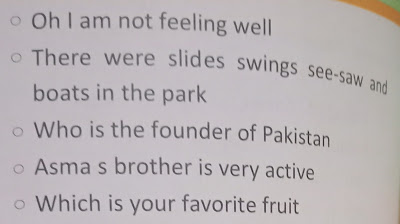Lesson Planning of Punctuation Marks Subject English Grade 3rd
Lesson Planning of Punctuation Marks
Subject English
Grade 3rd
Students` Learning Outcomes
- Apply punctuation rules to assist accuracy and fluency in reading.
Information for Teachers
- Punctuation makes the text meaningful. It ensures correct expressions and intonation.
- Intonation is the rise and fall in speech. Speech can be made effective by using variety in speech.
- Pronounce words and take pauses while reading, i.e. stopping at full stops, commas and question marks.
- Rules of punctuation:
- A question mark (?) is used at the end of a sentence when a question is asked.
- An exclamation mark (!) is used to show strong feelings.
- An apostrophe (`) is used to show possession.
- A comma (,) is used to show a pause in the sentences, or when naming a list of items.
Material / Resources
Writing board, chalk / marker, duster, different
coloured charts paper, cutouts of the punctuation marks, punctuation passage
(worksheet) flash cards of punctuation marks(. , ? ! ``) in 3x 1 size on
different coloured chart papers
Introduction
- Write down the sentence without any punctuation marks on the board, as such;
“I like the toy you are holding will you give it to me”
- Read out the following sentence a little fast without taking pauses.
- Ask a question from students:
- What did I talk about? (Expected answer; you talked about a toy. No, I did not understand, no, you were too fast)
- Ask the students to suggest where the punctuation marks should be added.
- Put the full stop and question mark with the coloured chalk.
- Read the sentence with proper punctuation and intonation.
“I like the toy you are holding. Will you give it to me?”
- Ask the students:
- What difference do you notice now? (Expected answer; we understood because you stopped while reading. You read it clearly. You read it slowly. You read it twice.
- Make the students recall the function of full stop (.), question mark (?), comma (,), and exclamation mark (!).
- Write simple sentences on board to show the function of punctuation marks, as such;
- This is my bat.
- I like to eat mangoes, oranges and grapes.
- Hurrah! I won the football match.
Development
Activity 1
- Paste flash cards of punctuation marks or draw them on the board.
- Ask the students to name them:
- Make small groups of four to five students each.
- Ask the students to select any paragraph from the textbook.
- Underline the given punctuation marks according to the criteria given below.
- Now ask the students the functions of each of them.
- Appreciate those students who give correct answers. Don`t discourage those students who give wrong answers.
Activity 2
- Write the following text on the writing board.
Text:
- ‘I was walking on mall road it was very hot and I was feeling very thirsty stopped under a tree why are standing here someone said i turned around and saw it was Ali my best friend’.
Solved text:
- ‘I was walking on Mall Road. It was very hot and I was feeling very thirsty. I stopped under a tree. “Why are standing here?” someone said. I turned around and saw it was Ali my best friend’.
- Call the students individually to the writing board.
- Ask the students to insert punctuation marks with the coloured chalk.
Let the class clap for every correct entry.
- Ask another student to do the correction in case a mistake is made.
- Ask the students to read the texts one by one with proper pauses, accuracy and fluency. Help the students to read fluently.
Activity 3
- Select a passage from the textbook which has all these punctuation marks.
- Make pairs of students.
- Ask all the students to read the text turn by turn to their partner. (One student reads other listens and corrects the mistakes, and then they change rules.)
- Take round of the class and listen to the students. Correct them if they make mistakes.
- All the students must follow the rules of punctuation.
Sum up / Conclusion
- Ask the students to put the punctuation marks in the blanks and make sure that the students have clearly learnt the rules of punctuation.
- All the students read these sentences one by one in class.
Follow up
- Put punctuation marks in the following sentences:
- When you say something to students in your daily routine, ask them to punctuate your sentence. For example, if you say, ‘why is junaid absent today’, write it on the board and ask students to punctuate it.
- All the students must read the next lesson at home with proper pauses and fluency.












Comments
Post a Comment